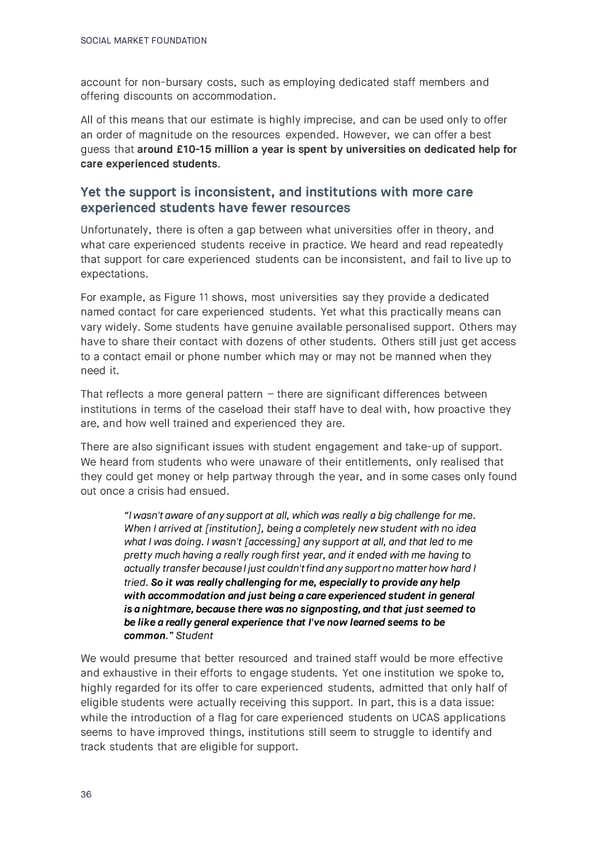SOCIAL MARKET FOUNDATION account for non-bursary costs, such as employing dedicated staff members and offering discounts on accommodation. All of this means that our estimate is highly imprecise, and can be used only to offer an order of magnitude on the resources expended. However, we can offer a best guess that around £10-15 million a year is spent by universities on dedicated help for care experienced students. Yet the support is inconsistent, and institutions with more care experienced students have fewer resources Unfortunately, there is often a gap between what universities offer in theory, and what care experienced students receive in practice. We heard and read repeatedly that support for care experienced students can be inconsistent, and fail to live up to expectations. For example, as Figure 11 shows, most universities say they provide a dedicated named contact for care experienced students. Yet what this practically means can vary widely. Some students have genuine available personalised support. Others may have to share their contact with dozens of other students. Others still just get access to a contact email or phone number which may or may not be manned when they need it. That reflects a more general pattern – there are significant differences between institutions in terms of the caseload their staff have to deal with, how proactive they are, and how well trained and experienced they are. There are also significant issues with student engagement and take-up of support. We heard from students who were unaware of their entitlements, only realised that they could get money or help partway through the year, and in some cases only found out once a crisis had ensued. “I wasn't aware of any support at all, which was really a big challenge for me. When I arrived at [institution], being a completely new student with no idea what I was doing. I wasn't [accessing] any support at all, and that led to me pretty much having a really rough first year, and it ended with me having to actually transfer because I just couldn't find any support no matter how hard I tried. So it was really challenging for me, especially to provide any help with accommodation and just being a care experienced student in general is a nightmare, because there was no signposting, and that just seemed to be like a really general experience that I've now learned seems to be common.” Student We would presume that better resourced and trained staff would be more effective and exhaustive in their efforts to engage students. Yet one institution we spoke to, highly regarded for its offer to care experienced students, admitted that only half of eligible students were actually receiving this support. In part, this is a data issue: while the introduction of a flag for care experienced students on UCAS applications seems to have improved things, institutions still seem to struggle to identify and track students that are eligible for support. 36
 Care and Learning in Higher Education Page 36 Page 38
Care and Learning in Higher Education Page 36 Page 38